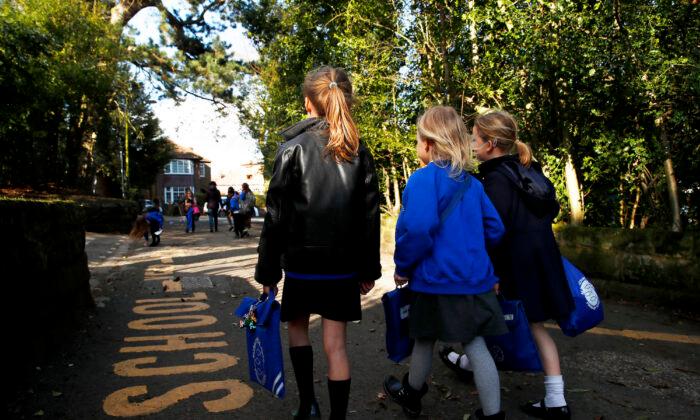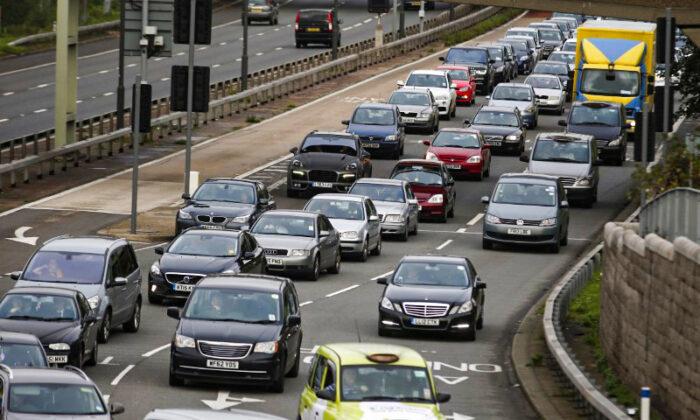Disadvantaged school children in England are falling behind their peers owing to the lingering impact of COVID-19 lockdowns, a new report states.
The National Audit Office (NAO) found loss of learning for children from disadvantaged backgrounds was not only “consistently greater,” but could lead to “increased disadvantage and significant lost earnings,” if not addressed.
Despite government efforts to help children catch up with lost lockdown learning, the gap in attainment has grown in England since 2019, according to the NAO.
Molly Kingsley, co-founder of parent campaign group UsForThem, told The Epoch Times: “It’s disappointing, but not surprising.
“A recovery tsar, Sir Kevin Collins, was appointed to assess what an adequate recovery package would cost, which was £15 billion.
“Two or three years later we are in a position where a small fraction of that has been offered.
“So it should surprise no one that the recovery programme is failing and it should surprise no one to see that it is disadvantaged kids being left further behind.
“It really reinforces that the government and unions need to get those kids back in school.”
The NAO report, “Education recovery in schools in England,” shows variation in how far and how quickly pupils have recovered learning from lockdown.
Department for Education (DfE) research showed “learning loss had reduced for most pupils” by the summer of 2021.
On average, pupils were 2.2, 0.9, and 1.2 months behind the expected level of attainment in primary maths, primary reading, and secondary reading respectively, compared with 3.6, 1.8, and 1.5 months in autumn 2020.
Missing Future Earnings
Fifty-nine percent of pupils reached DfE’s expected standard in all of reading, writing, and maths—down from 65 percent in 2019.The disadvantage gap index—a measure of the difference in attainment between disadvantaged and other pupils—at the end of primary school was 3.23 in 2022, compared with 2.91 in 2019.
An index score of 0 would indicate that there was no disadvantage gap.
If left unaddressed, lost learning “may lead to increased disadvantage and significant missing future earnings for those affected,” NAO said.
The watchdog recommended that DfE should “further develop its approach to monitoring progress towards achieving its ambitions for pupils’ attainment, and report regularly on progress.”
The report added: “DfE should also model the impact of withdrawing the subsidy for the NTP and the recovery premium after 2023/24, to assess whether tutoring in schools is financially sustainable given DfE’s objective for tutoring to become embedded in the school system.”
Disadvantaged pupils are those who have been eligible for free school meals at any point in the past six years, and may also include children who have ever been looked after by their local authority.

Ongoing Duty to Children
Around half of the pupils receiving tutoring under the government’s flagship National Tutoring Programme (NTP)—which aims to help pupils catch up on learning missed during the pandemic—were disadvantaged in 2021–2022.The report said 51 percent of pupils receiving tutoring through the tuition partners scheme were disadvantaged, short of the DfE’s target of 65 percent for that scheme, and 47 percent of pupils receiving school-led tutoring were disadvantaged.
Responding to the findings, Dame Meg Hillier, chair of the Commons Public Accounts Committee, said: “DfE must stay focused on addressing learning loss for all children, as it works to close the attainment gap between disadvantaged children and their peers, which widened during the pandemic.
“The long-term cost of failing to do so is huge, for pupils and wider society. DfE has an ongoing duty to the children who missed out on education and continue to pay the price.”
In a statement released on Wednesday, a DfE spokesperson acknowledged there was “more to do” in closing the disadvantage gap in education.
“Almost three million courses have been started through the National Tutoring Programme, revolutionising the way that targeted support is provided in schools,” the spokesperson said.
“And whilst we’re pleased to see that today’s findings indicate that children are making progress, we know that there is more to do, including working to close the disadvantage attainment gap.”
The department said it was“investing more than £5 billion over the next two years on pupil premium funding to improve the outcomes for disadvantaged pupils across England.
Pandemic Impact on Schools
The report’s findings on the ongoing impact of COVID-19 lockdowns on school children come less than a month after NHS figures revealed more than a million children needed serious mental health treatment during the pandemic.Data analysed by the PA news agency showed a 39 percent rise in a year for referrals for NHS mental health treatment for under-18s, to 1,169,515 in 2021 to 2022.
This was a jump from 839,570 in 2020 to 2021.
A total of 12,965 pupils were kicked out of schools in England because of “wilful and repeated transgression of protective measures.”





